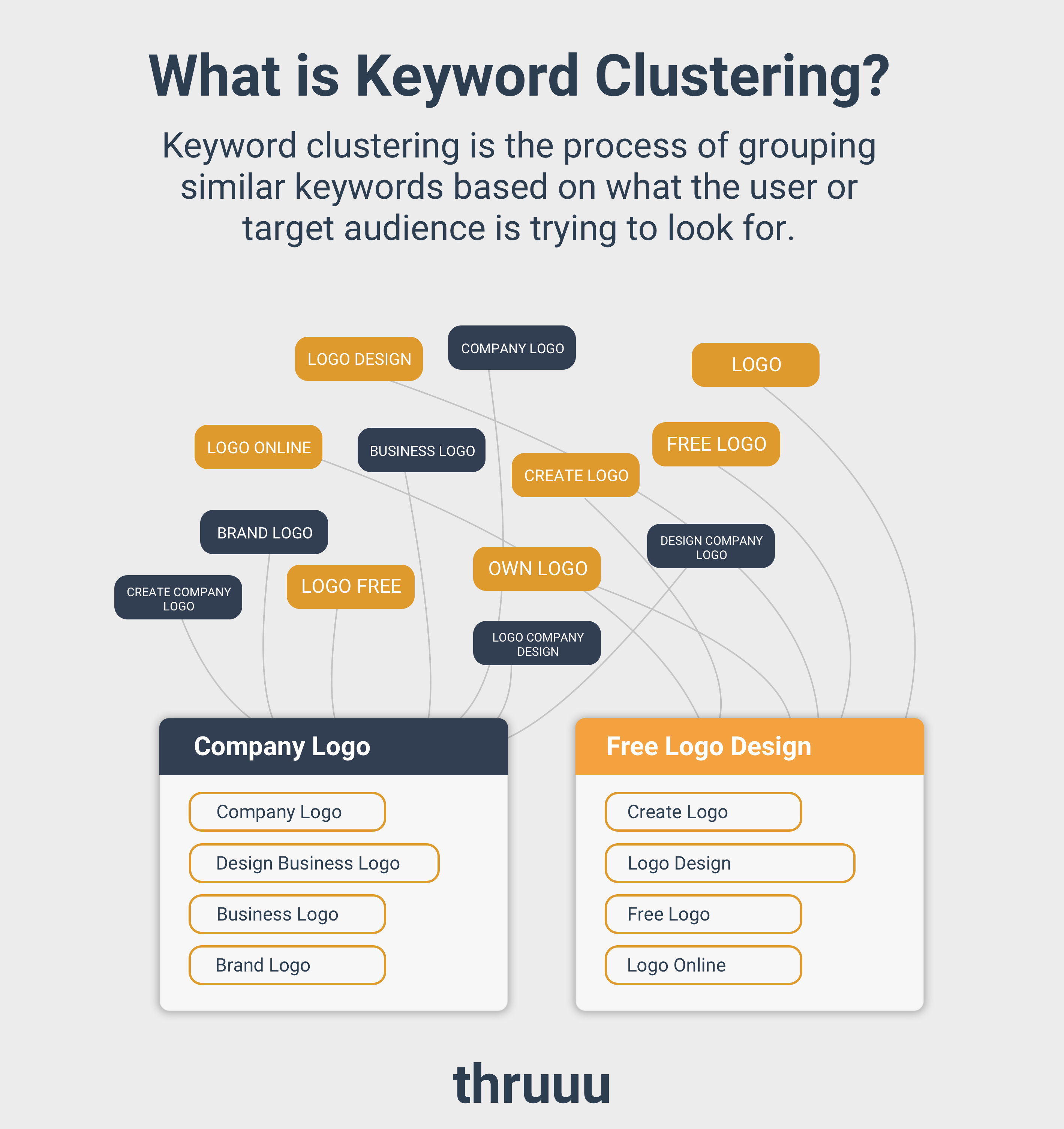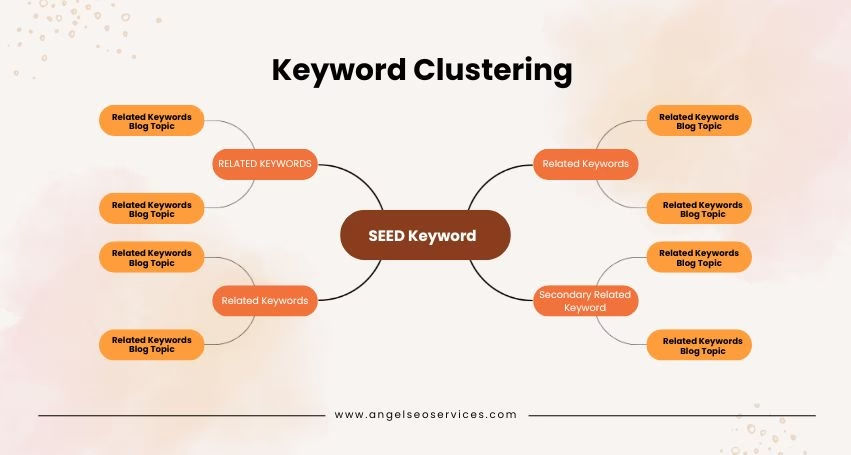“`html
Introduction: Unlock Your SEO Potential with Keyword Clustering
Estimated reading time: 10 minutes
Key Takeaways
- Keyword clustering represents a significant evolution in modern SEO strategy.
- It involves grouping semantically related keywords by topic and user intent, moving beyond single-term optimization. Sources: keysearch.co, semrush.com.
- Effective SEO keyword research now requires a holistic approach to topics and user journeys. Sources: keysearch.co, brandwell.ai.
- Building topic clusters leads to better search rankings and increased organic traffic by covering a broader spectrum of relevant queries. Sources: keysearch.co, semrush.com.
- This structured method helps search engines understand your website’s authority on specific subjects.
Table of contents
- Introduction: Unlock Your SEO Potential with Keyword Clustering
- Key Takeaways
- Understanding Keyword Clustering: Why It’s Essential for Your SEO
- The Mechanics of Keyword Clustering: A Step-by-Step Process
- From Keyword Clusters to Content: Building Your Topic Clusters
- The Tangible Benefits of Implementing Keyword Clustering
- Navigating the Pitfalls: Common Mistakes in Keyword Clustering
- Frequently Asked Questions
In the dynamic world of digital marketing, staying ahead of the curve in Search Engine Optimization (SEO) is paramount. For years, the prevailing wisdom in SEO keyword research revolved around identifying individual keywords and crafting content around them. However, a fundamental shift is underway. This shift is driven by the concept of keyword clustering, a sophisticated approach that redefines how we think about content strategy and search engine visibility. Rather than optimizing for isolated terms, keyword clustering focuses on grouping semantically related keywords based on their topic and, critically, the user’s search intent. This method recognizes that users rarely search for single, isolated terms when seeking information. Instead, they explore topics from various angles, using a range of related queries. By understanding and catering to these clusters of intent, businesses can build more comprehensive, authoritative content that resonates deeply with both users and search engines. This structured approach, often referred to as building topic clusters, promises not only better search engine rankings but also a significant increase in organic traffic by capturing a wider array of relevant searches. It’s a move towards a more natural and user-centric way of approaching SEO, ensuring that your website becomes the go-to resource for comprehensive information on your chosen subjects. This means moving beyond the simple identification of keywords to a deeper understanding of user journeys and informational needs.

Understanding Keyword Clustering: Why It’s Essential for Your SEO
At its core, keyword clustering is the strategic process of organizing keywords into logical groups that share a common meaning and user intent. This isn’t just about finding words that are similar; it’s about understanding the underlying topic and the information a user is seeking when they type those words into a search engine. By consolidating related keywords, you create an opportunity to build content that comprehensively addresses all facets of a subject. Sources: seranking.com, bluetonemedia.com.
But *why* is this method so crucial for your SEO efforts? The answer lies in how search engines operate and how they interpret website content. When you focus on a cluster of related keywords, you’re essentially signaling to search engines that your website is an authority on that entire topic, not just a single, isolated keyword. This broad authority boosts your visibility for a collection of related terms, rather than being limited to the ranking potential of just one. Source: keysearch.co.

The limitations of solely focusing on single keywords in SEO keyword research are becoming increasingly apparent. This narrow approach can lead to several issues. Firstly, it restricts your ranking potential. You might rank well for a specific long-tail keyword, but miss out on the vast opportunities presented by its related terms. Secondly, and perhaps more critically, it significantly increases the risk of keyword cannibalization. This occurs when multiple pages on your own website compete against each other for the same search terms, diluting your authority and confusing search engines about which page is the most relevant to rank. Keyword clustering effectively mitigates this by creating a clear, hierarchical structure for your content, ensuring each page has a distinct purpose and contributes to the overall topical authority of your site. Source: keysearch.co.
The Mechanics of Keyword Clustering: A Step-by-Step Process
Implementing keyword clustering involves a systematic approach. It begins with identifying a core concept or topic you want to rank for and then selecting a primary keyword that best represents that topic. This primary keyword will serve as the foundation for your cluster. Source: semrush.com.
Following this, the crucial research phase begins. Your goal here is to uncover a wide range of supporting keywords. This includes long-tail variations, related questions, and any other search queries that users might employ when exploring your chosen topic. This research should be thorough, aiming to capture the full spectrum of user interest.

This leads to the essential step of keyword analysis. This analysis goes beyond simply finding keywords; it’s about understanding how users actually phrase their questions and search for information related to your topic. By examining search queries, forum discussions, and related searches, you can uncover valuable secondary keywords and identify emerging trends that you might otherwise miss. This deep dive into user language is critical for building a truly effective cluster. Source: semrush.com.
Once you have a substantial list of keywords, the next step is the grouping process. This involves consolidating your keyword findings into logical topic clusters. The key to successful grouping is assessing the semantic similarity between keywords and observing the SERP overlap. SERP overlap refers to whether the same search results appear for different queries. If multiple queries consistently bring up the same set of search results on Google, it’s a strong indicator that those queries belong in the same cluster, as they likely share the same user intent. Sources: seranking.com, semrush.com.

This methodical process ensures that your keyword research is not just a list of terms, but a strategic blueprint for content creation that aligns with user needs and search engine logic. It moves you from a scattered approach to a focused, topic-driven strategy, building a robust foundation for your SEO success.
From Keyword Clusters to Content: Building Your Topic Clusters
The true power of keyword clustering is realized when you translate these keyword groups into a coherent content strategy. The practical application involves mapping each identified keyword cluster to a specific piece of content. Typically, this structure involves creating a central “pillar” page that comprehensively covers the primary keyword and the overarching topic. This pillar page then acts as a hub, with dedicated “cluster content” pages that delve deeper into the specific subtopics and secondary keywords identified during your keyword analysis. Source: semrush.com.
A critical element in this structure is internal linking. Establishing strong, logical internal links between your pillar pages and their corresponding cluster content is paramount. This practice serves multiple vital functions. Firstly, it clearly signals these content relationships to search engines, helping them understand the topical hierarchy and authority of your site. Secondly, it guides users logically through your content, allowing them to explore related aspects of a topic without leaving your website. This interconnectedness not only builds topical authority but also enhances user experience and site navigation. Sources: bluetonemedia.com, semrush.com.

This interconnected content structure, built around topic clusters, is fundamental to strengthening your overall SEO strategy. It provides search engines with essential context, demonstrating a deep understanding and coverage of specific subjects. By linking related content together, you are essentially creating a network of information that reinforces your site’s expertise and authority. This not only improves your chances of ranking for a wider range of keywords but also boosts your site’s overall domain authority in the eyes of search engines. Source: brandwell.ai.
Think of it like building a knowledge base. The pillar page is the main encyclopedia entry, and the cluster content pages are the detailed articles linked from it, each exploring a specific facet of the main subject. This organized approach ensures that users can easily find the information they need, whether they’re looking for a broad overview or specific details, thereby improving engagement and reducing bounce rates.
The Tangible Benefits of Implementing Keyword Clustering
The strategic implementation of keyword clustering yields significant and measurable advantages for your SEO efforts. One of the most prominent benefits is improved rankings and traffic. By targeting an entire cluster of related keywords with a single pillar page and its supporting content, you create the potential for that page to rank for dozens, if not hundreds, of related search queries simultaneously. This leverages the combined search volumes of a topic, leading to a substantial increase in overall organic traffic. Sources: keysearch.co, semrush.com.

Beyond sheer volume, keyword clustering also leads to enhanced user experience. When your content comprehensively addresses all aspects of a topic within a well-structured cluster, users are more likely to find complete answers to their questions in one place. This reduces the need for them to navigate away to other sites, which in turn can lower bounce rates and increase the time spent on your website, positive signals that search engines value. Sources: keysearch.co, bluetonemedia.com.
Furthermore, this method significantly impacts your site’s authority and credibility. By thoroughly covering a topic through well-structured and interlinked clusters, you establish your website as a definitive resource. Search engines recognize this depth of coverage and reward it with higher domain authority, a key factor in overall SEO performance. Sources: bluetonemedia.com, brandwell.ai.

Keyword clustering also promotes more efficient content creation. When you have clearly defined keyword clusters, you gain a roadmap for your content priorities. This helps avoid duplication of effort, as you know exactly which subtopics need to be covered and where. By preventing content from competing with itself, you mitigate keyword cannibalization and ensure that your resources are used effectively to build comprehensive topical authority. Sources: keysearch.co, bluetonemedia.com.
Finally, the process of clustering and analyzing keywords provides deeper insights into your audience and their search behavior. As part of the clustering process, you naturally expose topical gaps in your existing content and uncover new content opportunities. This data is invaluable for informing a more robust and strategic content strategy, ensuring that you are consistently creating content that meets user needs and aligns with search engine expectations. Source: semrush.com.

Navigating the Pitfalls: Common Mistakes in Keyword Clustering
While keyword clustering offers immense benefits, there are common pitfalls that can undermine its effectiveness if not carefully avoided. One significant mistake is creating overly broad or narrow clusters. Mixing completely unrelated terms into a broad cluster dilutes the content’s focus and confuses search engines about its core topic. Conversely, splitting highly similar keywords that share the same intent into separate, narrow clusters can lead to content fragmentation and missed opportunities for comprehensive coverage. Source: semrush.com.
Another critical error is failing to assign a clear primary keyword for each cluster. The primary keyword acts as the central theme and the main target for your pillar page. Without this clear designation, your content can lack focus, making it difficult for both users and search engines to understand what the page is primarily about. This ambiguity weakens your SEO efforts. Source: semrush.com.

It is also essential to actively consider user intent throughout the keyword analysis and clustering process. Ignoring user intent can lead to the creation of content that, while perhaps keyword-rich, is ultimately irrelevant to what a searcher is trying to achieve. This mismatch results in lower engagement, higher bounce rates, and missed ranking opportunities, as search engines prioritize content that best satisfies user queries. Sources: seranking.com, semrush.com.
Finally, the consequence of neglecting internal links within your topic clusters cannot be overstated. While creating the content is important, failing to implement strategic internal linking between your pillar pages and cluster content means missing out on the opportunity to build strong topical authority and effectively pass SEO value throughout your site. These links are the connective tissue that holds your cluster strategy together, reinforcing relationships and aiding crawlability. Source: semrush.com.

By being aware of these common mistakes and proactively addressing them, you can ensure that your keyword clustering strategy is robust, effective, and aligned with best practices for achieving sustainable SEO growth.
Frequently Asked Questions
Q1: What is the primary goal of keyword clustering?
A1: The primary goal is to group semantically related keywords based on topic and user intent to create comprehensive content that signals topical authority to search engines, leading to improved rankings and traffic for a broader range of queries.
Q2: How does keyword clustering differ from traditional keyword research?
A2: Traditional keyword research often focuses on individual keywords. Keyword clustering takes a broader, topic-centric approach, organizing related keywords into groups to build more authoritative and comprehensive content. It emphasizes user intent more heavily.

Q3: What is SERP overlap, and why is it important for keyword clustering?
A3: SERP overlap refers to the phenomenon where different search queries yield similar or identical search engine results pages (SERPs). It’s important because it indicates that these queries likely share the same user intent and can therefore be grouped into the same keyword cluster.
Q4: How do internal links play a role in topic clusters?
A4: Internal links are crucial for connecting pillar pages with their supporting cluster content. They help search engines understand the relationship between these pages, build topical authority, and guide users through related information on your site.
Q5: Can keyword clustering help prevent keyword cannibalization?
A5: Yes, by creating a clear structure where a primary keyword and its related terms are addressed by a specific pillar page and its cluster content, keyword clustering helps ensure that different pages on your site don’t compete against each other for the same search terms.

Q6: What are some common mistakes to avoid when implementing keyword clustering?
A6: Common mistakes include creating clusters that are too broad or too narrow, failing to assign a clear primary keyword, ignoring user intent, and neglecting to implement strategic internal linking between related content pieces.
Q7: Is keyword clustering a one-time process?
A7: No, keyword clustering should be an ongoing part of your SEO strategy. As new keywords emerge and user behavior evolves, you may need to revisit and refine your clusters to maintain relevance and effectiveness.
Q8: What tools can I use for keyword clustering?
A8: While there isn’t one definitive tool, many SEO platforms offer features that aid in keyword clustering, such as Semrush, Ahrefs, and Keysearch. Manual analysis of SERP overlap and keyword similarity is also highly effective.

Q9: How does keyword clustering benefit user experience?
A9: By providing comprehensive content that fully addresses a topic within a cluster, users can find all the information they need in one place, leading to increased satisfaction, lower bounce rates, and longer time spent on your site.
Q10: Can keyword clustering improve my website’s overall authority?
A10: Absolutely. By thoroughly covering topics with interconnected content, you establish your website as an authoritative source, which search engines reward with higher domain authority and better overall search performance.

“`






